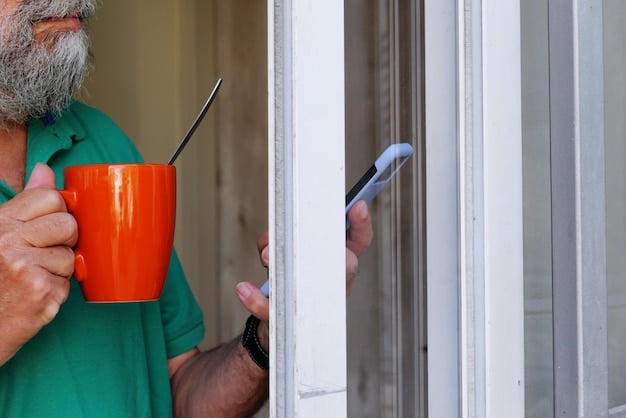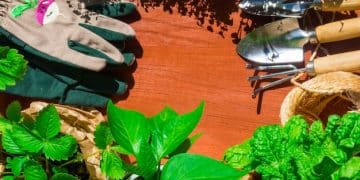Sustainable Pest Control: Your Organic Guide to a Chemical-Free Home & Garden

Achieving pest control through sustainable, chemical-free methods is not only possible but essential for fostering a healthier, more balanced home and garden ecosystem, safeguarding both human health and biodiversity.
In our modern world, the pursuit of a harmonious living environment often clashes with the persistent challenge of pests. However, an increasing number of homeowners and gardeners are discovering that sustainable pest control: protect your home and garden without harmful chemicals is not merely an idealistic aspiration, but a highly effective and practical reality. This comprehensive guide will explore how to manage unwanted invaders in your space while preserving the health of your family, pets, and the planet.
The Imperative of Sustainable Pest Control: Why Go Chemical-Free?
The traditional approach to pest management, often relying heavily on synthetic pesticides, carries a hidden cost far beyond the immediate expense. These chemicals, while effective at eliminating target pests, frequently inflict collateral damage on beneficial insects, such as pollinators and pest predators, disrupting the intricate balance of the ecosystem. Moreover, residues from these substances can linger in our soil, water, and even within our homes, posing potential health risks to humans and pets alike.
Choosing sustainable pest control is not just an eco-friendly trend; it’s a fundamental shift towards a more responsible and effective strategy. It acknowledges the interconnectedness of living systems, promoting methods that work with nature rather than against it. By avoiding harmful chemicals, we safeguard our family’s well-being, protect vital biodiversity, and contribute to a healthier planet for future generations. This holistic approach ensures that our homes and gardens are not just free of pests, but are also vibrant, thriving environments.
Understanding the Risks of Chemical Pesticides
The allure of quick fixes often leads to the widespread use of chemical pesticides. However, delving deeper reveals a concerning array of potential hazards:
- Environmental Contamination: Pesticides can leach into groundwater, contaminate rivers and lakes, and drift into non-target areas, harming aquatic life and delicate ecosystems.
- Health Concerns: Direct exposure, inhalation, or ingestion of pesticide residues can lead to various health issues, including respiratory problems, neurological disorders, and in some cases, even increased cancer risk.
- Resistance Development: Over-reliance on a single chemical can lead to pests developing resistance, rendering the pesticide ineffective over time and necessitating stronger, more harmful alternatives.
The Benefits of Holistic Pest Management
Embracing a holistic approach to pest control offers a multitude of benefits, extending far beyond simply eradicating unwanted visitors. It is about fostering resilience and long-term health within your home and garden. This philosophy emphasizes prevention, ecological balance, and non-toxic interventions, ensuring that your environment thrives without compromise.
By prioritizing the health of your soil, encouraging beneficial insect populations, and making mindful choices about plant selection, you create a natural defense system. This reduces your reliance on external interventions, saving time and resources in the long run. The result is a vibrant, self-sustaining ecosystem where plants, animals, and humans can coexist peacefully and healthily.
Ultimately, transitioning to sustainable pest control is an investment in the future. It’s a commitment to protecting our natural resources, ensuring food safety, and preserving the delicate balance of life on Earth. This responsible stewardship cultivates a healthier, more beautiful reality for everyone.
Preventive Strategies: Your First Line of Defense Against Pests
The most effective pest control strategy begins with prevention. By proactively addressing potential vulnerabilities, you can significantly reduce the likelihood of infestations, minimizing the need for reactive measures. This involves a thoughtful assessment of your environment, both indoors and outdoors, and implementing simple yet powerful changes that deter pests naturally.
From maintaining garden hygiene to sealing entry points in your home, preventive strategies form the cornerstone of sustainable pest management. They capitalize on understanding pest behavior and preferences, creating an unwelcome environment for them from the outset. This forward-thinking approach not only saves you time and resources but also establishes a resilient, pest-resistant living space by design, not by reaction.

Home Exclusion Techniques
When it comes to indoor pests, restricting their entry is paramount. Many common household pests, from ants to rodents, gain access through surprisingly small openings. A thorough inspection of your home’s exterior is the first step:
- Seal Cracks and Gaps: Use caulk or weatherstripping to seal cracks in foundations, around windows, and doorframes. Pay special attention to utility entry points where pipes and wires enter the house.
- Repair Screens: Mend any tears in window and door screens to prevent flying insects from entering.
- Install Door Sweeps: Gaps under exterior doors can be easily closed with door sweeps, creating an effective barrier.
These seemingly minor fixes can make a significant difference in preventing a wide array of pests from establishing themselves inside your living space. Regular vigilance and prompt repairs are key to maintaining an impenetrable perimeter.
Garden Hygiene and Landscaping Practices
A well-maintained garden is inherently less attractive to pests. Good gardening practices create a healthy plant environment that can naturally resist invaders. Consider these essential habits:
- Remove Debris: Leaf litter, fallen fruits, and rotten wood provide shelter and food for many pests. Regular clean-up eliminates these attractive habitats.
- Proper Watering: Overwatering can lead to fungal growth and create damp conditions favored by slugs and snails. Water at the base of plants in the morning to allow foliage to dry.
- Pruning: Remove dead or diseased plant material, as these can attract pests. Improve air circulation through proper pruning, making plants less susceptible to disease and insect attack.
Beyond these, consider the strategic placement of plants. Companion planting, where certain plants deter pests from others, is a highly effective, natural defense mechanism that works in harmony with your garden’s ecosystem. These proactive measures greatly reduce the need for intervention.
Natural and Organic Pest Control Remedies
For those times when prevention isn’t quite enough, a wealth of natural and organic remedies offers effective solutions without resorting to harsh chemicals. These methods harness the power of botanical extracts, beneficial organisms, and simple household ingredients to manage pest populations responsibly. The emphasis here is on targeted interventions that minimize disruption to the broader environment.
From homemade sprays to introducing predatory insects, these remedies provide diverse tools for tackling specific pest issues. They are designed to be low-impact, breaking down quickly in the environment and posing minimal risk to non-target species. Embracing these natural solutions supports a vibrant, healthy ecosystem, ensuring your home and garden remain beautiful and productive without toxic trade-offs.
Homemade Pest Control Solutions
Many effective pest deterrents can be crafted using ingredients readily available in your pantry. These DIY solutions are not only cost-effective but also give you complete control over what you’re applying in your environment.
- Neem Oil Spray: Derived from the neem tree, this oil disrupts insect growth and feeding. Mix with water and a tiny bit of mild soap to create an emulsified spray for aphids, spider mites, and whiteflies.
- Garlic and Chili Pepper Spray: The strong odors and pungent taste of these ingredients deter many chewing insects. Blend garlic cloves, chili peppers, and water, strain the mixture, and dilute before spraying on affected plants.
- Dish Soap Solution: A simple solution of a few drops of mild dish soap per gallon of water can effectively smother soft-bodied insects like aphids and mealybugs. Ensure it’s a pure soap, not a detergent that might harm plants.
Always test any homemade spray on a small, inconspicuous part of the plant first to ensure it doesn’t cause damage before applying broadly. Consistency is key for these remedies.
Biological Pest Control: Unleashing Nature’s Predators
Nature has its own intricate systems for keeping pest populations in check. Biological pest control involves introducing or encouraging the presence of beneficial organisms that prey on or parasitize common garden pests. This method is incredibly effective and ecologically sound.
Ladybugs, for instance, are voracious eaters of aphids. Lacewings feed on a variety of soft-bodied insects, and parasitic wasps target caterpillars and other pests. Encouraging these natural predators through suitable habitat and diverse planting is a cornerstone of sustainable gardening. You can also purchase and release them in your garden for immediate impact.
Creating a diverse garden with a variety of flowering plants provides nectar and pollen for these beneficial insects, ensuring they have a food source even when pest populations are low. This creates a self-regulating ecosystem where pests are naturally kept under control, reducing your workload and increasing the overall health of your garden.
Gardening for Pest Resilience: Companion Planting and Biodiversity
Designing your garden with resilience in mind means leveraging the power of nature’s diversity. Companion planting and fostering biodiversity are two cornerstones of this approach, transforming your garden into a robust ecosystem that naturally resists pests. It’s about creating a living tapestry where plants support each other, deter unwelcome visitors, and attract allies.
By thoughtfully combining different plant species, you can confuse pests with strong scents, lure them away from valuable crops, or even improve the health and vigor of your plants. This symbiotic relationship reduces the need for synthetic inputs, promoting a healthier soil, more vibrant plants, and a sustainable, productive garden that thrives on its own terms.
The Power of Companion Planting
Companion planting is an age-old practice that combines specific plants for mutual benefit, often leading to natural pest deterrence. It’s a subtle yet powerful form of biological control, utilizing natural plant chemistry and biology to protect your crops. For instance, planting marigolds near vegetables is known to repel nematodes and other harmful insects.
Similarly, certain herbs like basil can deter flies and mosquitoes, while also enhancing the flavor of tomatoes. Nasturtiums act as a trap crop, luring aphids away from more desirable plants. By integrating these pairings into your garden design, you create a complex interplay of scents and deterrents that confuse and repel pests, significantly reducing their impact.
The beauty of companion planting lies in its simplicity and effectiveness. It requires understanding the specific relationships between plants and pests, but once implemented, it transforms your garden into a more resilient and self-regulating system, minimizing the need for active intervention.
Attracting Beneficial Insects
A thriving garden ecosystem relies heavily on the presence of beneficial insects. These are the unsung heroes that pollinate your plants and, more importantly, prey on or parasitize the pests that decimate your crops. Creating an inviting habitat for them is crucial for natural pest management. Examples include:
- Ladybugs: Predator of aphids, scale insects, and spider mites. Attract them with dill, cilantro, and cosmos.
- Lacewings: Larvae feed on aphids, mealybugs, and whiteflies. Attract them with angelica, dill, and coriander.
- Hoverflies: Larvae consume aphids; adults are crucial pollinators. Attract them with daisies and sweet alyssum.
- Parasitic Wasps: Target caterpillars and other pest larvae. Attract them with parsley, carrots, and yarrow.
Providing a consistent source of nectar and pollen, as well as shallow water sources, will ensure these beneficial insects not only visit your garden but also establish permanent populations, turning your garden into a self-sustaining pest defense system.
Addressing Specific Pest Challenges Sustainably
Even with the best preventive measures, specific pest challenges can emerge. The key to sustainable management is to identify the pest accurately and then apply the most targeted, least toxic solution. This tailored approach minimizes broad application of remedies, focusing only on what is necessary to restore balance. Effective sustainable pest control allows for precise intervention, ensuring minimal impact on beneficial insects and the environment.
From understanding the life cycles of common pests to deploying specific biological agents, addressing individual pest problems sustainably requires knowledge and patience. It’s about being a detective in your garden, observing patterns, and then choosing the most appropriate tool from your chemical-free arsenal. This adaptive strategy ensures that your garden remains healthy and productive while preserving ecological integrity.
Common Garden Pests and Their Organic Counterparts
Different pests require different approaches. Knowing your enemy is half the battle when it comes to effective organic pest control. For instance, aphids, those tiny, soft-bodied insects, can quickly decimate young plants. A strong spray of water can dislodge them, or a simple insecticidal soap solution can smother them effectively.
For slugs and snails, beer traps or barriers of crushed eggshells can be remarkably effective. Caterpillars, while potentially destructive, can often be hand-picked off plants, especially in smaller garden settings, or managed by encouraging parasitic wasps. Understanding the pest’s biology allows for the most humane and environmentally friendly intervention.
Spider mites, which thrive in hot, dry conditions, can be controlled with regular misting of plants to increase humidity, or by applying neem oil. Each pest presents its unique puzzle, and sustainable solutions encourage thoughtful, targeted responses rather than blanket applications.
Dealing with Household Pests Naturally
Indoor pests also require a careful, non-chemical approach, especially in living spaces occupied by children and pets. Ants, for example, are often seeking food and water. Locating their entry points and blocking them is crucial. Baking soda and sugar traps can also be effective non-toxic baits.
For cockroaches, maintaining impeccable cleanliness, repairing leaks, and using boric acid in cracks and crevices can be highly effective. Remember to apply it in areas inaccessible to children and pets. For fleas, a combination of regular vacuuming, washing pet bedding, and using diatomaceous earth on carpets and pet resting areas can break their life cycle.
Prevention remains paramount indoors: proper food storage, promptly cleaning up spills, and sealing entry points. Natural solutions often require more consistent effort than chemical sprays, but the benefit of a toxin-free home environment is immeasurable.
Long-Term Strategies for a Pest-Resilient Environment
Building a pest-resilient environment is not a one-time task but an ongoing commitment to ecological balance. Long-term strategies focus on creating self-sustaining systems that naturally deter pests and promote overall well-being. This vision extends beyond mere pest elimination to fostering a thriving ecosystem where problems are prevented by design, not just solved by intervention.
It involves continuous learning, adaptation, and an understanding of the subtle interactions within your home and garden. By embracing practices that enrich soil, encourage native species, and minimize external disturbances, you cultivate a space that is inherently robust. This holistic approach ensures lasting protection, reduced maintenance, and a healthier, more vibrant living space for years to come.
Soil Health and Plant Vigor
Healthy plants are inherently more resistant to pests and diseases. The foundation of plant health lies in vibrant, living soil. Enriching your soil with organic matter such as compost improves its structure, water retention, and nutrient availability, leading to stronger, more vigorous plants. Pests often target weak or stressed plants, so robust growth acts as a powerful deterrent.
Practices like no-till gardening and cover cropping also contribute to improved soil health, fostering a diverse microbial community that supports plant roots. When plants are well-nourished and thriving from the roots up, they are better equipped to withstand pest attacks and recover quickly from any damage. Investing in your soil is investing in a pest-free future.
Monitoring and Early Detection
Diligent monitoring is a critical component of any sustainable pest management plan. Regularly inspecting your plants and home for early signs of pest activity allows for quick, targeted intervention before populations explode. Early detection means you can often use the least invasive methods, such as hand-picking or a simple water spray, saving you time and effort in the long run.
Learn to recognize common pest signs, such as chewed leaves, unusual spots, or tiny insects congregating. Pay attention to the undersides of leaves and new growth, where pests often hide. Implementing sticky traps for flying insects or yellow trays with soapy water can also help you track pest presence and gauge population levels. Proactive observation empowers you to act swiftly and sustainably.
Beyond the Garden: Sustainable Pest Control Indoors
While the garden often gets the spotlight in sustainable pest control discussions, applying these principles inside your home is equally vital. After all, a healthy indoor environment is just as crucial for well-being. Sustainable practices indoors focus on exclusion, sanitation, and non-toxic interventions to keep your living spaces pest-free without resorting to harmful chemicals that can impact indoor air quality and family health.
This approach transforms your home into a less hospitable environment for common household pests like ants, cockroaches, and rodents. It’s about proactive management and understanding pathways, rather than reactive chemical treatments. By integrating these strategies, you create a harmonious, healthy, and genuinely safe haven for your family and pets, free from unwanted invaders and toxic residues.
Kitchen and Pantry Management
The kitchen and pantry are prime targets for pests due to the abundance of food sources. Effective sustainable pest control in these areas hinges on meticulous cleanliness and proper food storage. Any crumbs, spills, or open food containers can attract ants, cockroaches, and pantry moths.
- Airtight Storage: Store all dry goods like flour, sugar, cereals, pasta, and pet food in airtight containers made of glass or heavy plastic. This not only prevents pests from accessing them but also keeps your food fresher.
- Cleanliness: Wipe down counters, sweep floors, and clean spills immediately. Don’t leave dirty dishes in the sink overnight. Regularly empty trash cans, especially those containing food waste.
- Infested Items: If you discover an infested item, seal it in a plastic bag and immediately discard it outside. Check surrounding items for signs of spread.
These practices create a less inviting environment for pests, making it difficult for them to find food and establish populations.
Bathroom and Laundry Room Strategies
Moisture-loving pests like silverfish, drain flies, and some types of cockroaches are often drawn to bathrooms and laundry rooms. Managing humidity and eliminating water sources are key sustainable strategies in these areas.
- Fix Leaks: Promptly repair any leaky pipes or faucets. Even small drips can create enough moisture to attract pests.
- Reduce Humidity: Use exhaust fans during and after showers, and consider a dehumidifier in particularly damp areas. Ensure proper ventilation.
- Clean Drains: Regularly clean sink and shower drains to remove hair and soap scum, which can be food sources and breeding grounds for drain flies.
- Seal Entry Points: Just like in other areas of the home, seal any cracks or gaps around pipes or baseboards that could serve as entry points.
By creating a dry, clean environment, you make these attractive pest habitats far less appealing, reducing the need for any chemical interventions.
| Key Point | Brief Description |
|---|---|
| 🌱 Prevention First | Seal entry points, maintain garden hygiene to deter pests before they arrive. |
| 🌿 Natural Remedies | Utilize neem oil, soap sprays, and other DIY solutions for safe pest control. |
| 🐞 Biological Control | Encourage beneficial insects like ladybugs to naturally manage pest populations. |
| 🏡 Indoor Strategies | Focus on cleanliness, proper food storage, and moisture control for a chemical-free home. |
Frequently Asked Questions About Sustainable Pest Control
Yes, often more so in the long term. While chemical methods offer a quick knockdown, sustainable strategies address root causes, creating a more resilient environment. They focus on prevention, natural deterrents, and fostering beneficial organisms, leading to lasting pest management without the recurring need for harsh treatments or the development of chemical resistance in pests.
For beginners, start with basic preventive measures: garden hygiene, sealing home entry points, and proper food storage. Simple remedies like insecticidal soap sprays for aphids or hand-picking larger pests are also easy and effective. Introducing companion planting with deterrents like marigolds is another straightforward step towards sustainable practices.
While complete elimination of every single pest might be challenging, you can significantly reduce and manage pest populations effectively without chemicals. A combination of exclusion, sanitation, and natural remedies creates an unwelcome environment for most common pests. The goal is management and balance, not absolute eradication, fostering a healthy ecosystem.
Companion planting utilizes strategic plant pairings to deter pests. Some plants emit scents that repel specific insects, while others act as “trap crops” to lure pests away from more valuable plants. Certain pairings can also attract beneficial insects that prey on pests, enhancing the garden’s natural defense system, creating a dynamic and self-regulating environment.
While generally safe, some natural remedies like essential oils can be potent and require dilution. Always test homemade sprays on a small plant area first. Diatomaceous earth can cause respiratory irritation if inhaled, so apply it carefully. The primary “risk” is often that results might not be as immediate as chemical interventions, requiring patience and consistent application.
Conclusion
The journey towards sustainable pest control: protect your home and garden without harmful chemicals is a testament to our ability to live in harmony with nature. By embracing preventive measures, harnessing natural remedies, and fostering biodiversity, we can create environments that are not only free from unwanted invaders but also thriving ecosystems rich in life and health. This approach requires patience, observation, and a willingness to learn from the natural world, but the rewards—a safer home, a flourishing garden, and a lighter footprint on the planet—are immeasurable. It’s an investment in the well-being of our present and future, proving that effective pest management doesn’t have to come at the expense of ecological integrity.





